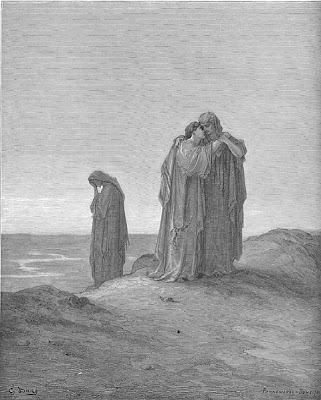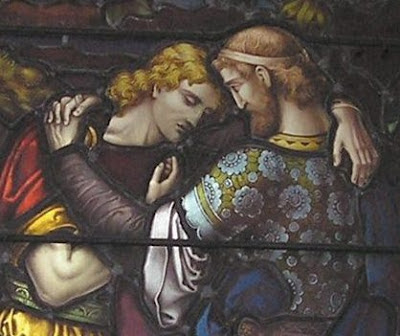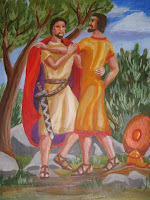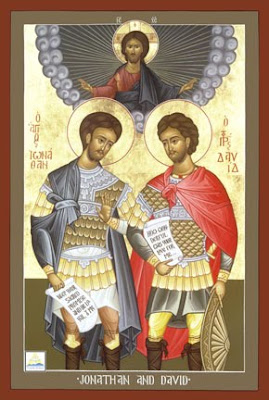“John the Apostle resting on the bosom of Christ,” Swabia/Lake Constance, early 14th century. Photo by Andreas Praefcke. (Wikimedia Commons)
John the Evangelist is commonly considered to be Jesus’ “Beloved Disciple” -- and possibly his lover. His feast day is today (Dec. 27).
The love between Jesus and John has been celebrated by artists since medieval times. And the idea that they were homosexual lovers has been causing controversy at least since the 16th century.
John was an apostle of Jesus and is the presumed author of the Gospel of John, the Book of Revelation and the Epistles of John. The Bible describes their warm relationship in depth. John left his life as a fisherman to follow Jesus, who nicknamed him “son of thunder.” John participated in many of the main events in Christ’s ministry. He was one of the three who witnessed the raising of Jairus' daughter, the transfiguration and Jesus' agony in Gethsemane.
The unnamed “disciple whom Jesus loved” is referenced five times in the gospel of John (John 13:23, 19:26, 20:22, 21:7, 20). Church tradition identifies him as John himself. He reclined next to Jesus at the Last Supper, resting his head on Jesus’ chest. He was the only male disciple present at the crucifixion. From the cross, Jesus entrusted the Beloved Disciple and his mother Mary into each other’s care. There is even a medieval European tradition that
John and Jesus were the bridal couple at the Cana wedding feast.
The idea that Jesus and his Beloved Disciple had a sexual relationship dates back at least to the early 16th century, when English playwright Christopher Marlowe was tried for blasphemy on the charge of claiming that “St. John the Evangelist was bedfellow to Christ and leaned always in his bosom, that he used him as the sinners of Sodoma.” In 1550 Francesco Calcagno, a citizen of Venice, was investigated by the Inquisition for making the heretical claim that “St. John was Christ’s catamite,” which means a boy or young man in a pederastic sexual relationship with an older man.
Many modern scholars have expressed belief that Jesus and his Beloved Disciple shared a an erotic physical relationship. They include Hugh Montefiore, Robert Williams, Sjef van Tilborg, John McNeill, Rollan McCleary, Robert E. Goss and James Neill. A thorough analysis is included in “
The Man Jesus Loved: Homoerotic Narratives from the New Testament![]()
” by Theodore Jennings, Biblical theology professor at Chicago Theological Seminary. He finds the evidence “inconclusive” as to whether the beloved disciple was John, but it leaves no doubt that Jesus had a male lover.
“A close reading of the texts in which the beloved disciple appears supports the hypothesis that the relationship between him and Jesus may be understood as that of lovers. As it happens, both Jesus and the beloved are male, meaning that their relationship may be said to be, in modern terms, a ‘homosexual’ relationship,” Jennings writes (p. 34).
An entire chapter is dedicated to John as the bride of Christ in the 2013 book “
Saintly Brides and Bridegrooms: The Mystic Marriage in Renaissance Art” by Carolyn D. Muir, art professor at the University of Hong Kong.
After Jesus died, John went on to build a close, loving relationship with his younger disciple and scribe, Prochorus, bishop of Nicomedia. Tradition says that John was the only one of Christ's original 12 apostles to live to old age, and the only one not killed for his faith. He died in Ephesus around 100 AD.
Over the centuries many artworks have illustrated the deep love between Jesus and his Beloved Disciple. One of the newest is the 2012 icon “Jesus and the Beloved Disciple” by
Laurie Gudim near the top of this post. Based in Colorado, Gudim is an artist, Jungian psychotherapist and progressive Episcopalian.
Her work uses a motif dating back at least to the 13th century. The long artistic tradition depicts John as the Beloved Disciple resting his head on the breast of Jesus. It can be seen in an early 13th-century
stained glass window at the Cathedral of St. Etienne at Bourges and in “Christus Johannes Gruppe” (Christ John Group) by the unknown Master of Oberschwaben. This sculpture spent many centuries in an Augustinian convent in Inzigkofen, a town in the region of Sigmaringen in southwestern Germany. A museum in Berlin acquired in it the early 20th century, and it is now housed in the Bode Museum of the Prussian Cultural Heritage Foundation.
“Christus Johannes Gruppe” (Christ John Group) by the unknown Master of Oberschwaben, oak sculpture, 1320.
The loving embrace between John and Christ was a popular subject during the early 1300s in Swabia, the region of Germany on the Swiss border near Bodenese (Lake Constance). Prolific artists created many versions. Today one of them is housed in the
Cleveland Museum of Art in Ohio.
Another fine early sculpture in this style is "St. John Resting on Jesus' Chest," circa 1320, which can be seen online at the
Museum Mayer van den Bergh in Antwerp and the
Web Gallery of Art. It was sculpted by Master Heinrich of Constance for the the Dominican convent of St. Catherine's valley in Switzerland. These were devotional images intended to help viewers deepen their connection to Christ.
In Germany the image is so important and iconic that it has even been made into a postage stamp. The subject is known as "Christus Johannes Gruppe" (Christ John Group) or
Johannesminne (John Love), with
minne being a Middle High German word for erotic-emotional love. Many of these images were actually created for women, not men, to contemplate. Most if not all of the Johannesminne statues were created for Dominican convents and nunneries. Wikimedia Commons displays a set of 10 statues of “John Love” (Johannesminne) in Germany at
this link.
A modern interpretation of the subject is “Christ the Bridegroom,” by Robert Lentz, a Franciscan friar known for his innovative icons. Author-priest
Henri Nouwen![]()
, famous but struggling with a secret gay identity, commissioned it in 1983. He asked for an icon that symbolized the act of offering his own sexuality and affection to Christ. Research and reflection led Lentz to paint Christ being embraced by his beloved disciple John, based on an icon from medieval Crete.
Christ the Bridegroom, Br. Robert Lentz, OFM, © 1985.
“Henri used it to come to grips with his own homosexuality,” Lentz said in an interview for my book “
Art That Dares![]()
,” which includes this icon and the story behind it. “I was told he carried it with him everywhere and it was one of the most precious things in his life.” Nouwen’s goal was celibacy and he did not come out publicly as gay before his death in 1996. The icon takes the Biblical theme of Christ as bridegroom and joins it to the medieval motif of Christ with John. The resulting image expresses their intimate friendship with exquisite subtlety.
The intimate bond between the two men is emphasized in “One of his disciples, whom Jesus loved” by the French painter Ary Scheffer (1795-1858).
Atlanta artist
Becki Jayne Harrelson painted another especially loving version of Jesus and the Beloved at the center of her “Last Supper.” Unlike the classic icons of Jesus and the Beloved Disciple, her painting shows the two men gazing at each other and holding hands. She is a contemporary lesbian artist who uses LGBT people as models in her religious art. Raised in a fundamentalist Christian family, she uses art to express her passion for justice. Her story is also told in “
Art That Dares![]()
.”
Another icon celebrating the love between Jesus and the beloved disciple was painted by
Jim Ru (below). It was displayed in his show “Transcendent Faith: Gay, Lesbian and Transgendered Saints” in Bisbee Arizona in the 1990s.
“Jesus and the Beloved Disciple” by Jim Ru
In recent years some artists have adapted the classic iconography to other racial and ethnic groups. For example, John Giuliani's “Jesus and the Beloved Disciple” shows the figures in the native dress of the Aymara Indians, descendants of the Incas who still live in the Andean regions of Chile, Peru and Bolivia. Giuliani is an Italian-American artist and Catholic priest who is known for making Christian icons with Native American symbols. He studied icon painting under a master in the Russian Orthodox style, but chose to expand the concept of holiness to include Native Americans, the original inhabitants of the Americas.
One more picture of Jesus and his beloved must be mentioned, even though permission was not granted to display it here on the Jesus in Love Blog (yet). It is well worthwhile to click the title to see this stunningly beautiful photo of Jesus and his Beloved Disciple as black Africans:
“Every Moment Counts” (from “Ecstatic Antibodies”) by Rotimi Fani-Kayode
Fani-Kayode (1955-1989) was a Nigerian photographer who explored themes of sexual and cultural difference, homoerotic desire, spirituality and the black male body, often in collaboration with his late partner Alex Hirst. Their last joint work was "Every Moment Counts" from 1989. In it a beloved disciple leans against black Christ figure who wears pearls over his dreadlocks as he gazes toward heaven. “The hero points the way forward for the lost boys of the world - the young street-dreads, the nightclub-chickens, the junkies and the doomed,” Hirst explains on their website.
A poem that addresses the homoerotic love between Jesus and John as is “Sweet Saint John was a Dancer” by a poet who wants to be known only as Joe. It begins:
on the shore of old Capernaum
a lovely boy not fit for fishing
or carpentry, or marrying.
They tell he left his empty boat
for the sake of the bold young fellow
who looked at him that April morn
and said, my love, come follow.
The whole poem is posted at Queering the Church in a post titled: “
The Third Dance of Christmas: A Fiddle Dance for St. John’s Day.”
I also wrote about John as the beloved disciple in my novels “Jesus in Love” and “At the Cross.” In honor of John’s feast day, I post this scene from “
Jesus in Love: A Novel![]()
.” Jesus, the narrator, remembers the day he met John:
I became distracted by the not unwelcome presence of somebody standing close behind me, closer than necessary in the loosely packed crowd. I sensed that it was John, and spun around to see him planted there like a tall cedar tree. He leaned against me, eyes flashing. “I can’t wait for the Messiah to come. I’ve seen him in visions.”
“Really? Tell me what you remember.” It was exciting to find someone who was aware of God’s efforts to communicate.
“The Messiah is like a gentle lamb who sits on a throne with a rainbow around it. And yet his eyes flame with fire, and a sharp sword comes out of his mouth to strike down evildoers.”
“The truth is large,” I said.
“Are you saying my vision isn’t true?” he challenged.
“No, I’m not saying that. I expect that you will see more.”
When John smiled, his faced crinkled into a fascinating landscape of wrinkles. His eyes felt black and mysterious like the midnight sky as they roamed over me. “Do you want a prayer partner tonight?” he asked.
If anyone else had asked, I would have said no, but I looked again at John’s handsome, bejeweled soul and his long, sinewy body.
“Sure,” I agreed impulsively.
Only then did I notice that the Baptist had finished preaching. John steered me toward the caves where the Baptist and his inner circle of disciples lived. Lower-ranking disciples were ready with water vessels and towels to assist everyone with ritual purification before we ate a spartan meal of locusts and wild honey. One of them approached me.
“Wash up, and we’ll get together after supper,” John said as we parted.
___
Related links:
Dec. 27: John the (Queer) Evangelist (Queering the Church Blog)
Pharsea’s World: Homosexuality and Tradition: Jesus, John and LazarusDisciple whom Jesus loved (Wikipedia)
St John the Evangelist and Prochorus” (Queer Saints and Martyrs)
Jesus’ Gay Wedding at Cana (Queering the Church)
San Juan el Evangelista: Discípulo Amado de Jesús (Santos Queer)
___
Special thanks to
Ann Fontaine for the introduction to Laurie Gudim.
_________
This post is part of the
LGBT Saints series at the Jesus in Love Blog. Saints and holy people of special interest to gay, lesbian, bisexual and transgender (GLBT) people and our allies are covered on appropriate dates throughout the year.
Copyright © Kittredge Cherry. All rights reserved.http://www.jesusinlove.blogspot.com/Jesus in Love Blog on LGBT spirituality and the arts
_________
Icons of Christ the Bridegroom, John the Evangelist and many others are available on cards, plaques, T-shirts, mugs, candles, mugs, and more at
Trinity Stores![]()





















 of South Africa and
of South Africa and  of New Jersey.
of New Jersey. 
 by Robert A. Bernstein
by Robert A. Bernstein by Amity Pierce Buxton.
by Amity Pierce Buxton.





 .’” It was published in 2011 by University of Texas Press. The anthology is edited by Alma Lopez and Alicia Gaspar de Alba. The two women were married in 2008, during the brief period when same-sex marriage was legal in California.
.’” It was published in 2011 by University of Texas Press. The anthology is edited by Alma Lopez and Alicia Gaspar de Alba. The two women were married in 2008, during the brief period when same-sex marriage was legal in California.
 .”
.”







 by Theodore Jennings is a comprehensive book that explores the possibility of Lazarus as Jesus’ lover -- and all the other major queer theories about the beloved disciple.
by Theodore Jennings is a comprehensive book that explores the possibility of Lazarus as Jesus’ lover -- and all the other major queer theories about the beloved disciple.
 by Stephen C. Carlson.
by Stephen C. Carlson. ” where Jesus raises him from the dead:
” where Jesus raises him from the dead:


























 .
.










 .” Jesus, the narrator, remembers the day he met John:
.” Jesus, the narrator, remembers the day he met John:













 ” by Symonds.
” by Symonds.



